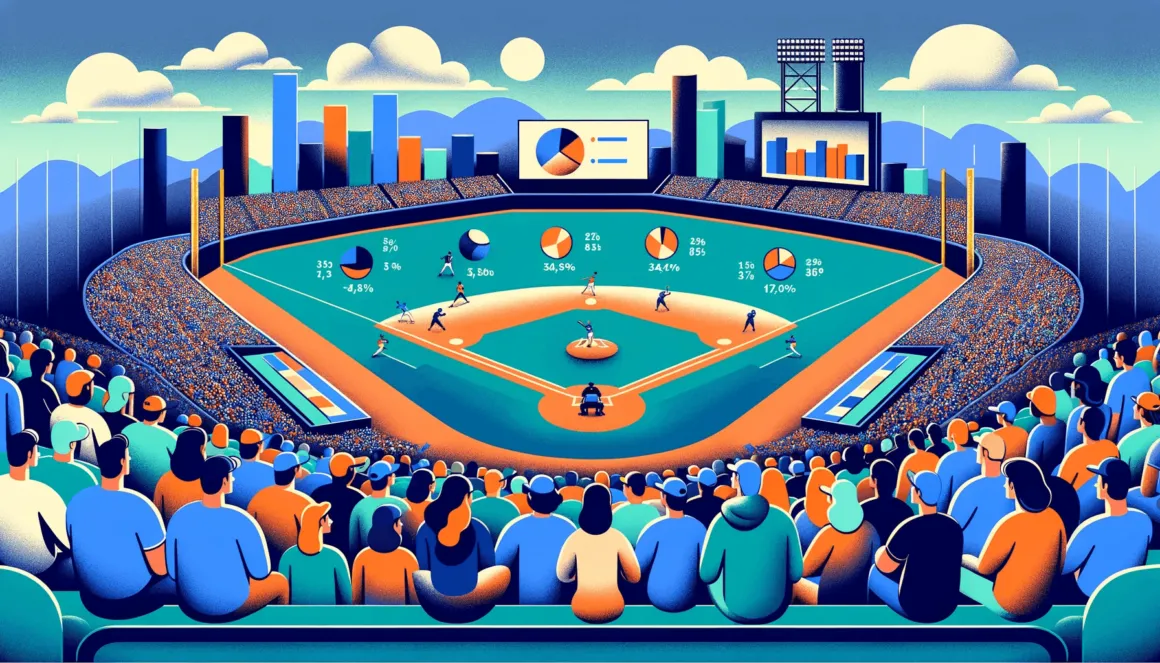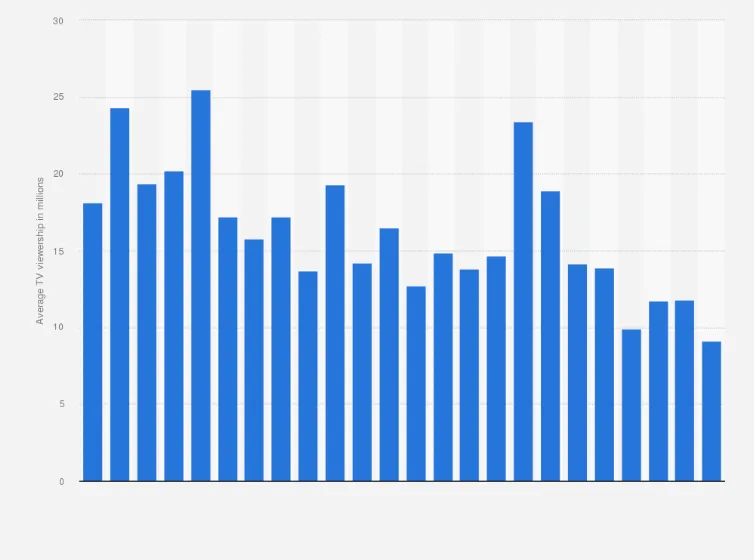Baseball has been America’s pastime for over a century, with a rich history and devoted fan base. From Major League Baseball (MLB) to college and youth leagues, the sport continues to capture the hearts of millions. But have you ever wondered about the viewership statistics behind this beloved game? In this article, we will take a deep dive into the latest baseball viewership statistics and explore the factors that contribute to its popularity. So, grab your peanuts and cracker jacks, and let’s get started!

The Rise of Baseball Viewership
The Evolution of Television and Its Impact on Baseball Viewership
One of the major factors in the rise of baseball viewership is the evolution of television. Before the 1950s, baseball games were primarily broadcasted via radio, limiting its reach to only those who could tune in. However, with the advent of television, the MLB saw an opportunity for expansion and began broadcasting games on a national level.
In 1953, the first-ever World Series was broadcasted on television, and by the 1960s, all MLB teams had their own television contracts. This not only gave fans the ability to watch their favorite teams from the comfort of their homes but also provided a new source of revenue for the league. Additionally, with the rise of cable television and satellite technology, baseball games can now be broadcasted to a global audience, further increasing its viewership.
The Impact of Digital Media on Baseball Viewership
While television played a crucial role in expanding the reach of baseball, the rise of digital media has taken it to a whole new level. With the proliferation of smartphones, tablets, and streaming services, fans can now access games and highlights anytime and anywhere.
According to a survey conducted by Nielsen Sports, 70% of baseball fans use digital devices to follow the sport, with 50% watching live games on their mobile devices. This shift towards digital media has also allowed for more targeted and personalized advertising, further increasing revenue for the league.
The Role of Social Media in Engaging Fans
In recent years, social media has become a powerful tool for engaging with fans and promoting the sport. Platforms such as Twitter, Facebook, and Instagram have allowed MLB teams and players to connect with their fans on a more personal level. From sharing behind-the-scenes moments to highlighting game highlights, social media has become an integral part of the baseball viewing experience.
Moreover, with the rise of influencer marketing, brands have started partnering with popular baseball players to promote their products, thereby reaching a wider audience. All of these factors contribute to the growing popularity of baseball and its viewership numbers.
The Impact of Major League Baseball (MLB) on Baseball Viewership

The Dominance of Major League Baseball (MLB)
When it comes to professional baseball, the MLB is undoubtedly the biggest and most dominant league. Comprising of 30 teams, the MLB has the highest average attendance out of all the major sports leagues in North America, with an average of over 28,000 spectators per game in the 2019 season.
The MLB also has a strong international presence, with players from over 20 countries making up its rosters. This diversity has not only helped widen the fan base but has also made the league more appealing to global audiences.
The Success of MLB’s Marketing Strategies
Another factor contributing to the growth of baseball viewership is the success of MLB’s marketing strategies. The league has been proactive in promoting the sport and engaging with fans, both digitally and through traditional marketing methods.
One of the key initiatives by the MLB is the “Play Ball” campaign, which aims to encourage youth participation in the sport. By partnering with organizations such as Little League and USA Baseball, the MLB has been able to introduce the game to a younger audience, ensuring its future growth.
Additionally, the MLB has also been successful in attracting new fans through creative digital campaigns. The “This is Baseball” campaign, launched in 2019, aimed to highlight the unique and diverse stories of players and fans, showcasing the game’s impact on people’s lives.
The Impact of Postseason and World Series on Viewership
The postseason and World Series are undoubtedly the most exciting times for baseball fans. As teams compete for the ultimate prize, the intensity and drama of each game draw in millions of viewers. In 2019, the World Series between the Houston Astros and Washington Nationals drew an average of 13.91 million viewers per game.
Moreover, with the rise of digital media and streaming platforms, fans can now watch these games from anywhere in the world, making it more accessible and increasing viewership numbers.
The Role of Players and Teams in Baseball Viewership
The Impact of Star Players on Viewership
Baseball has seen its fair share of iconic players, from Babe Ruth and Jackie Robinson to modern-day stars like Mike Trout and Aaron Judge. These players not only bring their exceptional talent to the field but also help drive viewership numbers.
For instance, when Derek Jeter announced his retirement in 2014, the Yankees saw an increase in ticket sales and viewership for their games. Similarly, in 2020, the Los Angeles Dodgers’ acquisition of Mookie Betts, one of the top players in the league, contributed to a significant increase in ticket sales for the team.
The Importance of Team Rivalries in Drawing in Viewers
Baseball has some of the most intense and longstanding rivalries in sports, and these rivalries often attract a large number of viewers. From the Red Sox vs. Yankees to the Dodgers vs. Giants, these rivalries create a sense of excitement and passion among fans, driving up viewership numbers for games between these teams.
Moreover, with the rise of social media, these rivalries have now extended to online platforms, with fans engaging in friendly banter and trash talk, further fueling the intensity of these matchups.
The Impact of Team Success on Viewership
The success of a team also has a direct impact on its viewership numbers. When a team is winning and performing well, it tends to attract more viewers, as fans are drawn to the excitement and drama of high-stakes games.
For instance, in 2016, when the Chicago Cubs made it to the World Series for the first time in over 70 years, they saw a 25% increase in ticket sales and an average viewership of 23.4 million viewers per game. This is a testament to how team success can drive viewership numbers and increase the popularity of the sport.
The Impact of COVID-19 on Baseball Viewership
The Disruption of the 2020 Season
In 2020, the world was hit by the COVID-19 pandemic, which had a significant impact on all sports leagues, including baseball. Due to health and safety concerns, the MLB was forced to postpone their season, and when it finally resumed in July, it was shortened to only 60 games.
This disruption not only affected the players and teams but also had a significant impact on viewership numbers. With no fans allowed at stadiums, the energy and excitement of the games were greatly diminished, leading to a decline in viewership.
The Rise of Online Streaming Platforms During the Pandemic
While the pandemic had a negative impact on traditional television viewership, it did lead to a rise in online streaming platforms. With people confined to their homes, many turned to streaming services like MLB.tv and ESPN+ to watch games.
Moreover, with the cancellation of other major sports leagues, baseball became one of the few live sports available for viewers, attracting new fans and increasing its reach. This further highlights the importance of digital media in driving the popularity and viewership of baseball.
The Impact on Revenue and Future Outlook
The COVID-19 pandemic also had a significant financial impact on the MLB. With the loss of ticket sales and decreased viewership, the league saw a decline in revenue, leading to salary cuts and layoffs within teams.
However, with vaccinations now rolling out and the 2021 season underway, things are looking up for the MLB. As stadiums begin to open up to fans, we can expect to see an increase in attendance and viewership numbers, providing a much-needed boost to the league’s finances.
The Role of Youth Baseball Leagues in Growing the Sport

The Importance of Youth Participation in Baseball
Youth participation is crucial for any sport’s long-term growth and success, and baseball is no exception. According to a survey by the Sports & Fitness Industry Association, baseball has seen an increase in youth participation in recent years, with over 5 million kids between the ages of six and twelve playing the sport.
Moreover, with the rise of travel teams and specialized training programs, young players now have more opportunities to develop their skills and compete at a higher level. This not only helps grow the talent pool for professional leagues but also creates a larger fan base for the sport.
The Impact of Title IX on Girls’ Participation in Baseball
Title IX, a federal law passed in 1972, prohibits discrimination based on sex in any educational program or activity that receives federal funding. While it was initially intended to promote gender equity in college sports, it has also had a significant impact on girls’ participation in youth baseball leagues.
Before Title IX, girls were often excluded from baseball teams and encouraged to play softball instead. However, with the implementation of Title IX, girls now have the opportunity to participate in co-ed baseball leagues, further promoting diversity and inclusivity in the sport.
The Growth of Youth Baseball Leagues Internationally
Baseball’s popularity is not limited to just North America; it has a global reach, with youth leagues popping up in different parts of the world. In Asia, countries like Japan, South Korea, and Taiwan have established professional leagues, with players from these countries making their mark in the MLB.
Moreover, with the inclusion of baseball in the Olympics, the sport has gained even more traction globally, with countries like Cuba, the Dominican Republic, and Venezuela becoming powerhouses in international competitions.
Conclusion
From its humble beginnings as a neighborhood game to becoming a multi-billion dollar industry, baseball has come a long way. And with the rise of technology and the growing diversity and inclusivity in the sport, its future looks bright.
The latest viewership statistics show that baseball continues to capture the hearts of fans worldwide, with an increase in digital media and streaming services only adding to its popularity. As the 2021 season progresses and fans return to stadiums, we can expect to see even higher viewership numbers, reaffirming the fact that baseball is truly America’s pastime.

